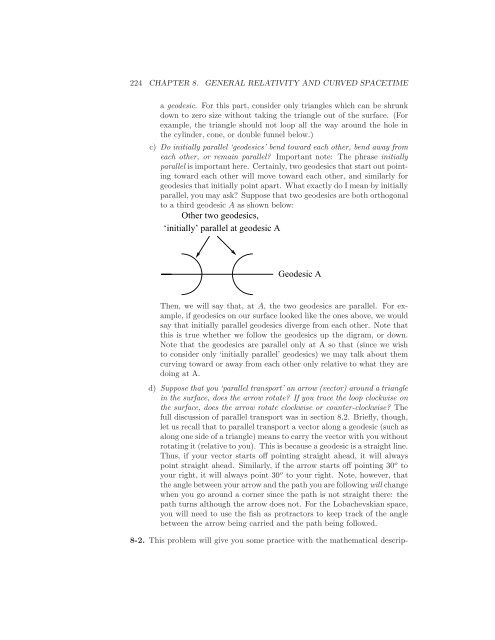Notes on Relativity and Cosmology - Physics Department, UCSB
Notes on Relativity and Cosmology - Physics Department, UCSB
Notes on Relativity and Cosmology - Physics Department, UCSB
Create successful ePaper yourself
Turn your PDF publications into a flip-book with our unique Google optimized e-Paper software.
224 CHAPTER 8. GENERAL RELATIVITY AND CURVED SPACETIME<br />
a geodesic. For this part, c<strong>on</strong>sider <strong>on</strong>ly triangles which can be shrunk<br />
down to zero size without taking the triangle out of the surface. (For<br />
example, the triangle should not loop all the way around the hole in<br />
the cylinder, c<strong>on</strong>e, or double funnel below.)<br />
c) Do initially parallel ‘geodesics’ bend toward each other, bend away from<br />
each other, or remain parallel? Important note: The phrase initially<br />
parallel is important here. Certainly, two geodesics that start out pointing<br />
toward each other will move toward each other, <strong>and</strong> similarly for<br />
geodesics that initially point apart. What exactly do I mean by initially<br />
parallel, you may ask? Suppose that two geodesics are both orthog<strong>on</strong>al<br />
to a third geodesic A as shown below:<br />
Other two geodesics,<br />
‘initially’ parallel at geodesic A<br />
Geodesic A<br />
Then, we will say that, at A, the two geodesics are parallel. For example,<br />
if geodesics <strong>on</strong> our surface looked like the <strong>on</strong>es above, we would<br />
say that initially parallel geodesics diverge from each other. Note that<br />
this is true whether we follow the geodesics up the digram, or down.<br />
Note that the geodesics are parallel <strong>on</strong>ly at A so that (since we wish<br />
to c<strong>on</strong>sider <strong>on</strong>ly ‘initially parallel’ geodesics) we may talk about them<br />
curving toward or away from each other <strong>on</strong>ly relative to what they are<br />
doing at A.<br />
d) Suppose that you ‘parallel transport’ an arrow (vector) around a triangle<br />
in the surface, does the arrow rotate? If you trace the loop clockwise <strong>on</strong><br />
the surface, does the arrow rotate clockwise or counter-clockwise? The<br />
full discussi<strong>on</strong> of parallel transport was in secti<strong>on</strong> 8.2. Briefly, though,<br />
let us recall that to parallel transport a vector al<strong>on</strong>g a geodesic (such as<br />
al<strong>on</strong>g <strong>on</strong>e side of a triangle) means to carry the vector with you without<br />
rotating it (relative to you). This is because a geodesic is a straight line.<br />
Thus, if your vector starts off pointing straight ahead, it will always<br />
point straight ahead. Similarly, if the arrow starts off pointing 30 o to<br />
your right, it will always point 30 o to your right. Note, however, that<br />
the angle between your arrow <strong>and</strong> the path you are following will change<br />
when you go around a corner since the path is not straight there: the<br />
path turns although the arrow does not. For the Lobachevskian space,<br />
you will need to use the fish as protractors to keep track of the angle<br />
between the arrow being carried <strong>and</strong> the path being followed.<br />
8-2. This problem will give you some practice with the mathematical descrip-
















